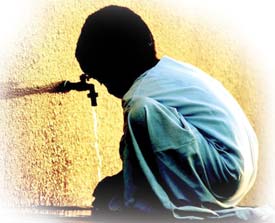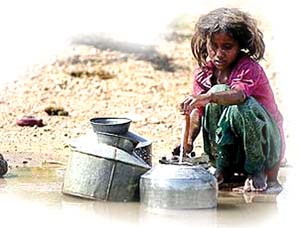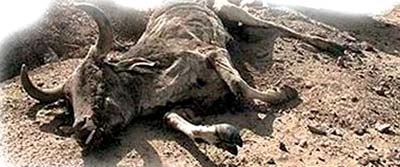Save that
drop
Everyone knows how precious water is; it is our lifeblood! But, if
the present trend of life continues with people abusing the many natural
resources, especially water Mother Nature has given us, we will soon
witness a different type of war; people or nations will have wars with
one another for the magic liquid of life, water!
 The
United Nations Population Fund predicts that the world will run out of
freshwater in 2050, but it may happen even sooner than that because of
the manner in which global warning has been increasing over the past few
years. The
United Nations Population Fund predicts that the world will run out of
freshwater in 2050, but it may happen even sooner than that because of
the manner in which global warning has been increasing over the past few
years.
|
"When just one
drop of water falls every second from a leaking tap about 1.5
litres of water is wasted a day." |
Many of you may think that a water crisis would not affect you right
now, going by the predictions and statistics, and continue to waste the
precious life giving liquid. But, please don't.
Try to save even that drop you waste because right at this very
minute, many humans and animals too are dying due to lack of freshwater
to drink. Even though you can quench your thirst just by opening a tap,
many people, even little children have to trek for miles in hazardous
conditions, to obtain freshwater to drink.
You may wonder why there should ever be a shortage of freshwater when
two-thirds of our planet is covered with water. So, let's check out some
valuable facts concerning this invaluable natural resource we all can't
do without.
How much of water is actually present on our planet? We see so many
rivers, waterfalls, lakes, springs (apart from the oceans) all over the
place and assume there's plenty to use. But, unfortunately, not all the
waterbodies contain drinkable or fresh water.
According to experts in the field, the volume of water available on
Planet Earth is 1.4 billion cubic km. But, hold on. All this is NOT
freshwater. Would you believe that more than 97 per cent of this water
is saline (salty) and present in the oceans? Then, even out of the 36
million cu.km of freshwater available on Earth, nearly 77 per cent (28
million cu.km) is frozen! And can you guess where it is?
In the glaciers and polar ice caps, including Greenland. So,
eventually the actual amount of freshwater left on Earth for us to use
as drinking water is ONLY 0.5 (eight million cu.km) of the total
quantity of water. And this precious water is found mostly in lakes and
rivers and as groundwater.

Only a small fraction is present above or in the air. Can you believe
that it's such a little amount of freshwater that is left for us to
drink and also use for cooking or washing? In order to understand how
little pure water we actually have to use, just imagine that all the
water in the world fits into a bottle.
What's left as freshwater would then be only (hold your breath), just
about a teaspoon! Now, do you realise why we should try to conserve
water?
Water cannot be produced in factories like most products because it's
a gift from Mother Nature. However, attempts are being made to
desalinate water. That is to turn sea water into freshwater. Now let's
examine another important factor the supply.
The supply of water has been constant over millions of years because
it is recharged through the water cycle - which is
 Mother
Nature's most efficient recycling mechanism. Mother
Nature's most efficient recycling mechanism.
If you are familiar with the water cycle, you'll understand that the
water you drink today may have even flowed down the Amazon river, the
Mississippi or come from the polar caps long, long ago, because, a drop
of water may spend two weeks or more in a river, a hundred years in a
lake or over a thousand years in a glacier, before reaching you! It
clearly indicates that the water supply of the world remains the same
over millions of years.
So, since the quantity of water available is constant and not
increasing it is everyone's responsibility to take stock of the amount
of water used, and initiate action to conserve this valuable resource.
However, like charity, conservation too should begin at home. Make
sure you don't waste water by keeping taps running unnecessarily while
you attend to some household chores or other work. You should conserve
water not only because you want to ensure the water bills at home are
kept low, but also because there's a scarcity of water in the world.
The statistics given by experts are alarming with regard to water
scarcity. Accordingly, by 2025 with a world population nearing 10
billion, the percentage of those with access to relatively sufficient
sources of water would have fallen to around 58 per cent.
Meanwhile, the number of those facing scarcity would have risen to 24
per cent.If Mother Nature can recycle its water we should also learn not
only to conserve, but also to recycle the water we use.
 Otherwise
the water that has existed for millions of years, since the time of the
dinosaurs, would eventually meet the same fate as them. Like the dinos
disappeared from the planet, all the freshwater would disappear from the
Earth and we'll have to scream "Water water everywhere, but not a drop
to drink." Otherwise
the water that has existed for millions of years, since the time of the
dinosaurs, would eventually meet the same fate as them. Like the dinos
disappeared from the planet, all the freshwater would disappear from the
Earth and we'll have to scream "Water water everywhere, but not a drop
to drink."
-----------**********
Water-related issues
* About 3.575 million people die each
year from water related diseases.
* Every 15 seconds, a child dies from
a water related disease.
* About 98 per cent of water-related
deaths occur in developing countries.
* About 884 million people lack
access to safe drinking water. That is approximately one in eight
people.
* Millions of women and children
spend several hours collecting water from distant, often polluted
resources.
Amount available and used
Water is a naturally circulating
resource which is constantly re-charged. And so freshwater is a
renewable source, but it's steadily decreasing today. As the world
population grows the demand far exceeds the supply.
* About 9,000 cubic kilometres of water is available in the world for
human use. Less than one per cent of freshwater is accessible for direct
human use.
* It is estimated that about 15 per cent of the worldwide water is
used for household purposes including drinking water, bathing, cooking,
sanitation and gardening. Basically, 50 litres per person per day,
excluding gardening.
Another 15 per cent is used for industrial purposes and around 69 per
cent for irrigation and agriculture.
Roughly it is estimated that about 54 litres of water is needed to
make just one kilogram of handmade paper, about 80 litres to dye one kg
of cloth, 0.5 litres to make one brick and 150 litres for dairy farming
just one cow.
* A person requires about 150 to 250 litres of water per day for
drinking (3-5 litres), cooking (20 litres), bathing (50 litres),
personal hygiene (50 litres) and laundry (40 to 60 litres).
-----------*********
|
Quick facts |
* At
birth, water accounts for 80 per cent of an infant's body
weight.
* By the time a person feels
thirsty, his/her body has lost over one per cent of its
total water amount.
* Hippocrates, the Father
of Medicine directed people in ancient Greece to boil and
strain water before drinking it. This proves that he was
aware of the impurities in water and the diseases it could
cause.
* The brain is made up of
approximately 85 per cent of water, while bones contain
approximately 33 per cent water.
* A healthy person can
drink about three gallons (48 cups) of water per day!
* One gallon of water is
equivalent to 3,785 litres of water while one cubic foot of
water equals 7.48 gallons.
* Water boils at 212
degrees Fahrenheit or 100 degrees Celsius and freezes at 32
degrees Fahrenheit or zero degrees Celsius.
* The total amount of
water available on Earth could be counted as 326 million
cubic miles.
* When water warms up it
turns into a gas called vapour.
* The first major water
reservoir of the world was built in 450 BC in South America.
It was used in the 19th century too.
* Surface water is water
in a river, lake or a freshwater wetland. Sub-surface water
or ground water is freshwater located in the pore space of
soil and rocks.
* With the scarcity of
water, scientists have proposed using icebergs as water.
* Desalination is a
process by which the world's saline water (generally sea
water) is converted into freshwater. |
Some countries with
freshwater
resources |
|
USA
China
India
Brazil
Iceland
Gabon
Papua New Guinea
Canada
New Zealand
Liberia
Norway
Congo
Bolivia
Peru |
|


